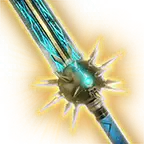I've been screwing around with things recently.
Designed a DM combo monster. Kinda similar to a mythic critter.
Reskinned a marilth as an Avatar of Bhaal slayer form added some legendary actions., saves, greater magic resistance and unstoppable 12. Buffed the HP.
2nd form was Bhaal. Used a DM special added mostly the above^^^.
Unstoppable to shrug off damage, reskinned Marilith with greater spell resistance to essentially ignore save or sucks. Fight 7 or 8 of the day 2 or 3 short rests including prayer of healing. 500+ hp between the two forms.
Vs level 12 PCs. Cleric finally ran out of spells at least high level ones.used a scroll of sunbeams (vs greater magic resistance)
Sorcerer more or less ran out as well. Had a summon dragon going. 1 lvl 6 spell saved for emergencies. Blew level 3 and 4s on counterspelks and Chromatic orb.
Bhaal had 4 attacks a round. 1d6+piercing damage and murder aura. +8d6poison. 1 reaction per turn, crots 18-20.
PCs had aid level 5 and heroes feast running. And temporary hot points from a variety of sources.
Think the fight went around 5 rounds. Unstoppable soaked up a few PC hits, I had to use legendary saves on stunning strike as the "slayer" flunked some saves.
Marilith rolled well. Shaved off half the rangers HP first round. Eventually they beat it down and it collapsed into a pike of gore. Only to have Bhaal emergencies. Rolled garvage+ wardingvflare. He got a couple of crits in though so 2d6+5X2 +16d6 poison damage.
Warlock Eldritch smites knocked one of them probe monk was burning focus points like candy. Unstoppable essentially negated most crits and 1/3rd the PCs damage 1/6th for monk (bit higher I used it vs his best attacks).
Stunning strikes, command spelks, hold monster, flurry of blows

rone failed.
Hex+level 6 scorching ray shaved off 80hp and I think the ranger piked the kill using this weapon.
Warlock was out of spells.
Sword of Chaos is a very rare +2 greatsword which deals additional Necrotic damage and also restores a portion of the wielder's health on each successful hit.
bg3.wiki
So 7 or 8 hours of real time 2 dungeons.
Encounters included.
1. Demons. CR10 one+ pets.
2. Banites
3. Bhaalists
4. Myrkulites
5. More Bhaalists
6. Mutilated adult black dragon. In a river of poo.
7. 8 green dragons pawn, 4 half dragon bhaal spawn. God's slayer dragon spawn
8. Sarevok (reskinned death knight) more bhaalists.
9. Bhaal. Reskinned+buffed Marilith+DM special buffed (elite death reaper of Bhaal buffed).
Might have been 3 sessions or a long one.
400 damage fireball, 25 danage Chromatic orb and a twinned hold monster cakewalked an encounter.
Fantasy Vietnam FML. It was 3 sessions over 5 weeks real time. 4 hour sessions one was 5.
Think I'll consider this a stress test.

